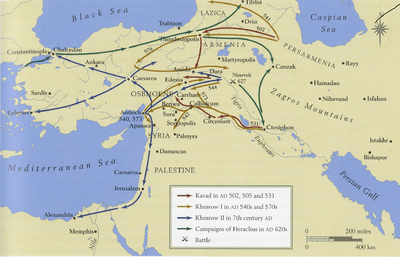Shahin's invasion of Asia Minor (615)
| Shahin's invasion of Asia Minor | |||||||
|---|---|---|---|---|---|---|---|
| Part of the Byzantine–Sassanid War of 602–628 | |||||||
 | |||||||
| |||||||
| Belligerents | |||||||
| East Roman (Byzantine) Empire | Sassanid Empire | ||||||
| Commanders and leaders | |||||||
| Heraclius, Philippicus | Shahin | ||||||
In 615, during the ongoing war with the Byzantine Empire, the Sassanid Persian army under spahbod Shahin invaded Asia Minor and reached Chalcedon, across the Bosporus from Constantinople. It was at this point, according to Sebeos, that Heraclius had agreed to stand down and was about ready to become a client of the Sasanian emperor Khosrow II, allowing the Roman Empire to become a Persian client state, as well as even allow Khosrow II to choose the emperor.[1][2] The Sassanids had already captured Roman Syria and Palestine in the previous year. After negotiations with Byzantine Emperor Heraclius, a Byzantine ambassador was sent to Persian Shahanshah Khosrau II, and Shahin withdrew again to Syria.
This was not the first time the Persians drew up their armies at the walls of Constantinople, but this time the invasion was more widespread. Beginning in 614 the Persians encroached on Asia Minor. In 614 they captured Melitene and Shahin divided his armies in two, one army marching to sack Sardis and Miletus and his army move towards Chalcedon. Despite the successful retreat back to Syria, the Persians did keep Caesarea (modern Kayseri) and the key Armenian fortresses of Theodosiopolis (modern Erzurum and Martyropolis). According to Sebeos, when they reached Chalcedon in 615, Heraclius had agreed to stand down and was about ready to become a client of the Sasanian emperor Khosrow II, allowing the Roman Empire to become a Persian client state, as well as even allow Khosrow II to choose the emperor.[1][2]
References
- 1 2 Pourshariati 2008, p. 141.
- 1 2 Pourshariati 2010, p. 1.
Sources
- Dodgeon, Michael H.; Greatrex, Geoffrey; Lieu, Samuel N. C. (2002). The Roman Eastern Frontier and the Persian Wars (Part I, 226–363 AD). Routledge. pp. 196–97. ISBN 0-415-00342-3.
- Frye, R. N. (1983). "The Political History of Iran under the Sassanids". In Yarshater, Ehsan; Bailey, Harold. The Cambridge History of Iran. Cambridge University Press. ISBN 978-0-521-20092-9.
- Howard-Johnston, James (2006). East Rome, Sasanian Persia And the End of Antiquity: Historiographical And Historical Studies. Ashgate Publishing. ISBN 0-86078-992-6.
- Pourshariati, Parvaneh (2008). Decline and fall of the Sasanian empire: the Sasanian-Parthian confederacy and the Arab conquest of Iran. I.B. Tauris. ISBN 978-1845116453.
- Pourshariati, Parvaneh (2010). The Sasanian Era. I.B.Tauris. ISBN 978-0857711991.